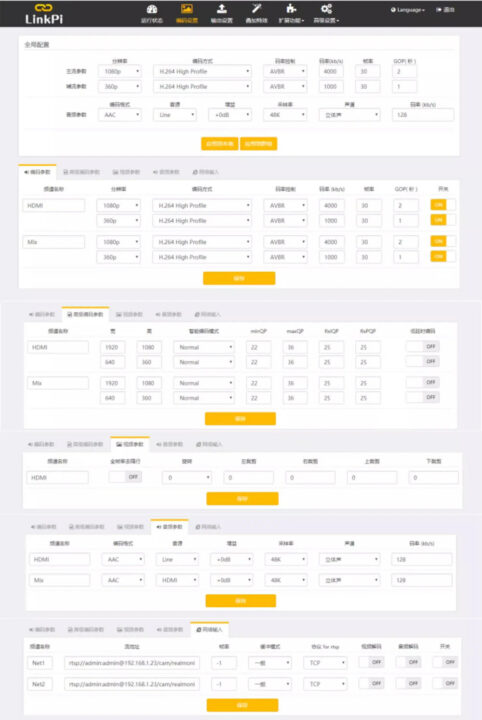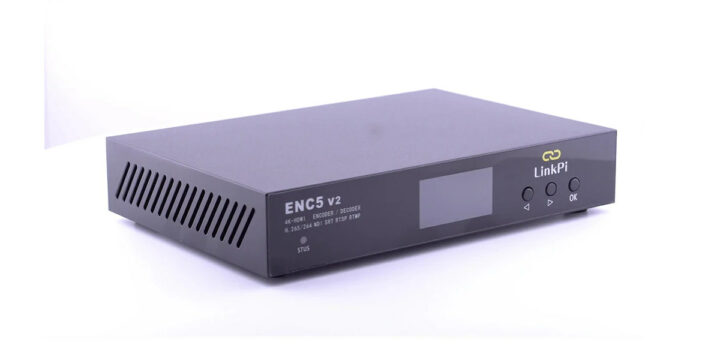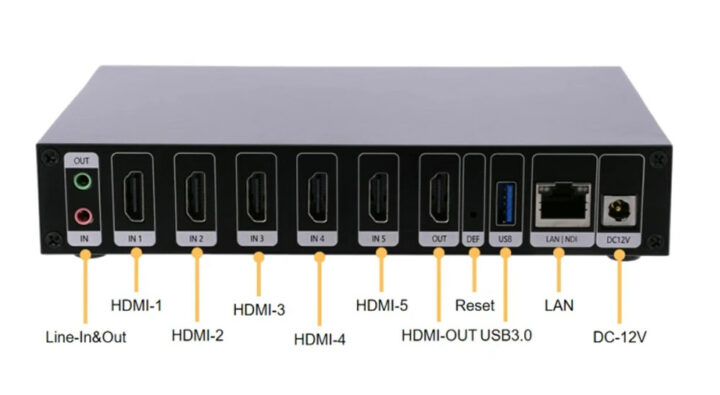The Link Pi ENC5 v2 is a video encoder with five HDMI inputs up to 4Kp30, one HDMI output, two audio jacks, Gigabit Ethernet, and a USB 3.0 port that supports RTSP, ONVIF, SRT, and NDI streaming protocols.
The system appears to be based on the Hisilicon Hi3531DV200 quad-core Cortex-A53 processor and features 8GB eMMC flash for the OS, plus 4GB RAM. The USB port can be used to record videos to an external hard drive or flash drive or add WiFi or 4G/5G cellular connectivity.
Link Pi ENC5 v2 specifications:
- SoC – Unnamed, but some of the specs are matching the Hisilicon Hi3531DV200 SoC
- CPU – Arm Cortex A53 quad-core processor @ 1.2GHz with 32KB l-Cache, 32KB D-Cache
- VPU
- Decode – H264, H264, MJPEG
- Encode – Up to 4Kp30 / 1080p60 H.264 Main/Baseline/High/ profiles, H.265 Main profile, MJPEG/JPEG
- Max Bitrate – 20Mbps
- Bit rate control – CBR, VBR, AVBR, FIXQP, QPMAP
- System Memory – 4GB DDR4
- Storage – 8GB eMMC flash
- Video Input – 5x HDMI 1.4 ports up to 4Kp30
- Video Output – 1x HDMI port up to 4Kp60
- Audio
- Input – 3.5mm Line-In jack, digital audio via HDMI input ports
- Output – 3.5mm Line-Out jack, digital audio output via HDMI output port
- Networking
- Gigabit Ethernet RJ45 port
- Optional external USB WiFi module
- Optional 4G/5G cellular via Huawei E8372 or LinkPi 5GCPE
- Protocols
- RTSP, RTMP, HTTP, HLS, UDP, unicast, multicast
- Support for ONVIF, SRT, NDI, and GB28181
- USB – 1x USB 3.0 for recording on a mass storage device
- Misc – Reset pinhole, menu button, front panel display
- Power Supply – 12VDC/2A
- Power Consumption – < 15W
- Dimensions – 176 x 126 x 33mm
- Temperature Range – 0~70°C
The system is configurable via a web interface where you can setup the network, perform firmware updates, and configure video recording/streaming, and other settings. The Link Pi ENC5 v2 supports “video mixing” with picture-in-picture, 4-split screen, and 9-split screen, special overlay effects such as adding a logo, watermark, subtitles, scrolling subtitles, timestamps, etc…
RTSP, ONVIF, SRT, and NDI (Network Device Interface) are supported, but the latter can only be used for 30 minutes by default and requires an extra license (“NDI Authorization”) from NewTek to remove the limitation and use all NDI features.

The LinkPi encoders have been available for a few years, but earlier models are based on the Hisilicon HI3520DV400 (quad-core Cortex-A7) or HI3531DV100 (dual-core Cortex-A9) processor. Mateusz Starzakhas set up a GitHub repository to follow the firmware updates, provides some information/tips, as well as hacks to improve security such as disabling telnetd since the default username/password are root/linkpi.com meaning anybody with access to your local network also has root access…
The latest Link Pi ENC5 v2 video encoder can be purchased on Aliexpress for $324.84 without the optional “NDI Authorization” which adds about $155. If you need a more versatile platform for development, I’ve noticed a Hisilicon Hi3531DV200 development board with two HDMI inputs but more I/Os, a simplified LinkSDK, and a web interface that looks very similar to the one in the Link Pi device.

Jean-Luc started CNX Software in 2010 as a part-time endeavor, before quitting his job as a software engineering manager, and starting to write daily news, and reviews full time later in 2011.
Support CNX Software! Donate via cryptocurrencies, become a Patron on Patreon, or purchase goods on Amazon or Aliexpress







5x HDMI inputs needs to be taken with a pinch of salt. Using Hi3531DV200 specs for 5x you would be limited to 1080P@30 encoding. 4 inputs allows 2×4K@30+2×1080P@30. I’d assumed the Hi3531DV200 provided native 5x hdmi inputs, but based on the specs looks they had to employ a hdmi to mipi IC to provide conversion for each input.
What about the output quality of these appliances? I guess that it is the usual low quality per bitrate typical of the hardware encoder in low-end ARM SoCs…
Here’s a sample I think I got when checking out the devkit.
https://www.youtube.com/watch?v=7hT-K3fsnq4
But what’s odd is that the end of the video talks about a dual A53, dual A73 processor instead.
Thanks, but it’s not really worth it… one would expect an .mp4 file with the exact output of the device; a 480p two-times encoded video with unknown settings, unknown source and unknown bitrate is not evaluable at all :/